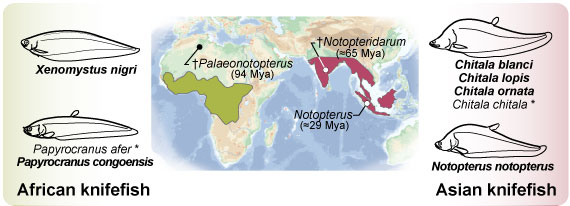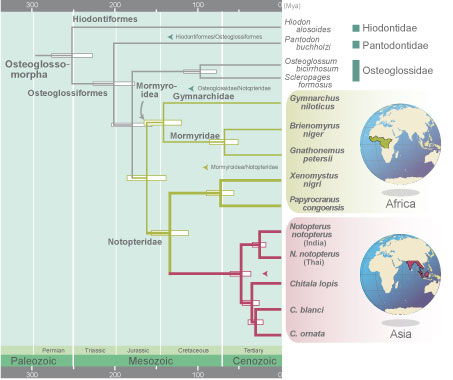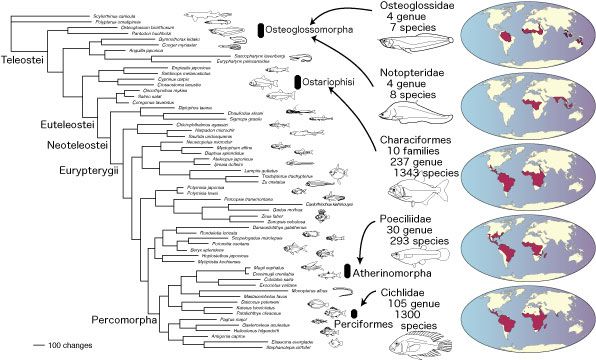|
|||
|
17 Feb. 2009
|
|||
|
Jun Inoue, Yoshinori Kumazawa, Masaki Miya, Mutsumi Nishida
|
|||
|
|
|||
Distribution pattern of knifefishThe continental distributions of freshwater fishes in the knifefish, family Notopteridae (Osteoglossomorpha), across Africa, India, and Southeast Asia constitute a long standing and enigmatic problem of freshwater biogeography. The migrational pathway of the Asian notopterids has been discussed in light of two competing schemes: the first posits recent transcontinental dispersal while the second relies on distributions being shaped by ancient vicariance associated with plate-tectonic events. |
|||
 |
|||
|
|
|||
|
|
|||
|
|||
 |
|||
|
|
|||
|
|||
 |
|||
|
(A) Estimated time of divergence based on the molecular evidence is at odds with the recent dispersal model. (B) It can be reconciled with the geological and paleontological evidence to support the vicariance model, "Out of India" hypothesis, in which the Asian notopterids diverged from the African notopterids in Gondwanaland and migrated into Eurasia on the Indian subcontinent from the Cretaceous to the Tertiary. India-Madagascar began to drift away during the middle to late Jurassic and completely separated from Gondwanaland (parts corresponding to the present Antarctica) 120-130 Mya and drifted northward. (C) We could not exclude an alternative explanation that the African and Asian notopterids diverged in Pangea before its complete separation into Laurasia and Gondwanaland, to which these two lineages were later confined, respectively. The supercontinent Pangea was split into Laurasia and Gondwana in the middle Jurassic (157-178 Mya). However, if model C were the case, it might be reasonable to expect the occurrence of notopterid fossils from regions connecting the two supercontinents. To the best of our knowledge, no such fossils are known. |
|||
|
|
|||
|
|||
 |
|||
|
|
|||
|
Recent technical developments in DNA sequencing and molecular dating have enabled examination of biogeographic hypotheses based on more realistic 'relaxed clock' assumptions of molecular evolution. The "out of India "hypothesis holds that some Asian biotic elements have an ancient Gondwanan origin and arrived in Asia by rafting on the Indian plate. Recent molecular phylogenetic and dating analyses also suggested an "out-of-India" migration in ranid frogs, ratite birds, arowanas, channids, and cichlids. |
|||
|
|
|||
|
|||
|
|
|||